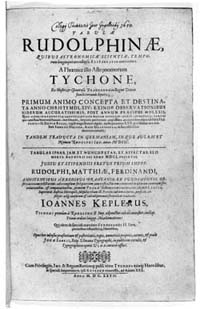Tycho Brahe and Astronomical Tables
 Title page from the Tabulae Rudolphinae.
Title page from the Tabulae Rudolphinae.
Image by kind permission of the Master and Fellows of Trinity College Cambridge.
According to his account in the Astronomiae instauratae mechanica (1598), Tycho realised that the positions of the planets agreed with neither the Alphonsine nor the Prutenic Tables whilst still a student in Leipzig. The observational reform of astronomy, which would furnish new and more accurate tables, was the great objective of the Tychonic astronomical project. It was for this reason that Tycho and his assistants worked to gather observations of the stars and planets, to determine from the reduced data the precise position of the celestial bodies, and to derive from these models of their motion.
By 1592, Tycho had produced a catalogue of 777 stars, the first new catalogue known to the Latin West since the time of Ptolemy. This catalogue was printed for inclusion in the Astronomiae instauratae progymnasmata, although the book was not completed and issued until 1602, after Tycho's death. The work also contained his solar theory, including tables, completed by 1589, and a section on the lunar motions which took Tycho the rest of his life to complete. In the meantime, further observations on the fixed stars were made, to bring the number in the Tychonic catalogue to 1000; although many of the additional stellar positions were less accurate than the earlier ones. Tycho sent manuscript copies of this star catalogue to potential patrons in 1598 and 1599, along with the printed Astronomiae instauratae mechanica. Emperor Rudolph II also received a manuscript ephemeris of daily positions of the sun and moon for the year 1599.
Astronomical tables for all the planets were eventually printed on the basis of Tychonic data, as was the 1000-star catalogue, but not until 1627. The Tabulae Rudolphinae were completed by Johannes Kepler, and in accordance with his planetary theory. Although it was not immediately recognised, the positions predicted in this work were generally around thirty times better than those of previous and competing tables.